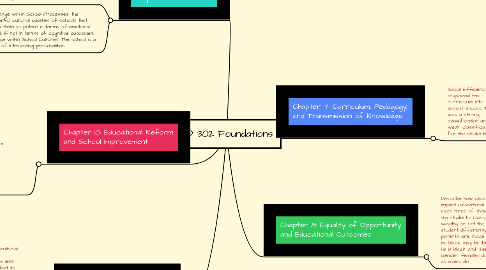
1. Chapter 7: Curriculum, Pedagogy, and Transmission of Knowledge
1.1. Social Efficiency: It organized the curriculum into distant tracks. There was a strong classification and a weak classification for the students.
1.1.1. Mimetic: It is mostly thought of what education is today. It gives a central place to the transmission of factual and procedural knowledge from one person to another. It has five steps: Test, Present, Perform/Evaluate, Reward/Fix, Enter Remedial Loop, and Advance.
1.1.1.1. Transformative: a transformation of one kind or another in the person being taught---a qualitative change often of dramatic proportion, a metamorphosis, so to speak. There is 3 steps: Personal modeling, "Soft" suasion, and Use of Narrative.
2. Chapter 8: Equality of Opportunity and Educational Outcomes
2.1. Describe how class, race, and gender each impact educational outcomes. I think that each three of these has a major effect on the students. Class: if your parents are wealthy or not the teachers may treat the student differently because of who their parents are. Race: the student who might be black may be taught differently because he is black and therefore he may drop out. Gender: females do not drop out as much as males do.
2.1.1. What were the two responses to the Coleman Study from 1982? public and private schools have also found that private schools seem to "do it better" for low income students. And the second response was socioeconomic composition of a school has a greater effect on student achievement than an individual's race and class.
3. Chapter 9: Explanations of Educational Inequality
3.1. Explain at least two types of cultural differences theory 1. African American children do less well in school because they adapt to their oppressed position in the class and caste structure. 2. Working class and nonwhite students as resisting the dominant culture of the schools. These students reject the white middle class culture of academic success and embrace a different, often antisocial culture (one that opposes to the culture of schooling)
3.1.1. Describe at least four school-centered (not student-centered) explanations for educational inequality. School financing, Effective School Research, Curriculum and Pedagogic Practices, and Curriculum and Ability Grouping and Gender and Schooling
4. Chapter 10: Educational Reform and School Improvement
4.1. Describe two school-based reforms (school-based, school-business partnerships, privatization, school-to-work programs, teacher education or teacher quality) School Based: School-Choice, Charter Schools, and Tuition Vouchers School-Business: The Boston Compact Privatization: Kaplan and Sylvan Learning Centers, have the majority of contracts for supplemental tutoring under NCLB. School-to-work: seed money to states and local partnerships of labor, education, and community organizations to develop these systems. Teacher Education: The Carnegie Report and the Holmes Group
4.1.1. Describe at least two societal, economic, community, or political reforms that impact education. Abbott V, Full Service Schools, Community Schools, Harlem Children Zone, and by connecting school, community and societal reforms.

